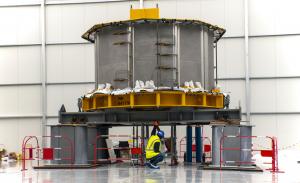Tests and verifications prior to assembly
This huge load is indispensable in order for the central solenoid to withstand the mechanical and magnetic forces it will be submitted to. These forces are equivalent to twice the thrust of a space shuttle...
Two central solenoid modules have already been delivered to ITER. The first one is presently undergoing a battery of tests and verifications—metrology, sensors and electrical insulation inspection, etc.
The remaining five modules (including one spare) are in the final stages of fabrication at General Atomics in California. All are expected to be delivered by mid-2023.
¹A meganewton (MN) is a unit of force corresponding to the force required to accelerate a mass of one million kilograms by one metre per second.


